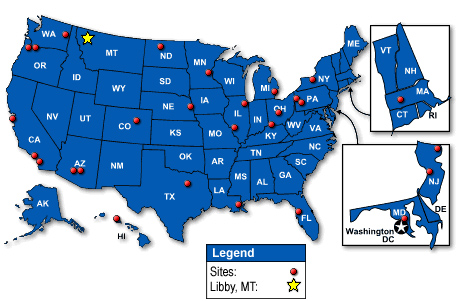Asbestos Toxicity
Where Is Asbestos Found?
Course: WB 2344
CE Original Date: January 29, 2014
CE Renewal Date: January 29, 2016
CE Expiration Date: January 29, 2018
Download Printer-Friendly version [PDF - 1.28 MB]
| Previous Section | Next Section |
Learning Objectives |
Upon completion of this section, you will be able to
|
||||||||||||
Introduction |
Asbestos was widely used in the United States until health concerns led to some uses being banned and some voluntary phase outs [Seidman and Selikoff 1990]. Since the early 1970s, use of asbestos has declined substantially; mining of asbestos ceased in the United States in 2002, though some asbestos continues to be imported [NIOSH 2011a]. Asbestos is still used in some construction materials. Some previously marketed asbestos-containing products, such as amphibole-contaminated vermiculite insulation, remain in many homes and other buildings in the United States. Asbestos fibers are released into the air when friable asbestos-containing materials are disturbed. In addition to being at risk for potential exposure from degradation of asbestos-containing commercial products, people in some areas of the world may be at risk because of geological deposits of asbestos at or near the earth's surface, which can release asbestos by natural weathering or man-made disturbance. Such deposits are often referred to as "naturally occurring asbestos." For more information on the subject of naturally occurring asbestos and maps showing the locations of naturally occurring asbestos: ATSDR website - https://www.atsdr.cdc.gov/PHS/PHS.asp?id=28&tid=4 United States Geological Services website - https://www2.usgs.gov/envirohealth/geohealth/images/GreaterThanBenchmarksMap.png |
||||||||||||
Current Commercial Uses |
Today, asbestos used in the United States is imported. Recent uses of asbestos in the Unites States include
|
||||||||||||
Former Commercial Uses |
Until the 1970s, asbestos was widely used in the construction, shipbuilding, and automotive industries, among others. For example, asbestos was formerly used in some of the following items:
These materials remain in many buildings, ships, and automobiles built before 1975 [Seidman and Selikoff 1990 ]. |
||||||||||||
Contaminated Commercial Products |
Asbestos has been a contaminant in other products such as Vermiculite contaminated with asbestos was produced as late as 1990 from a mine near Libby, Montana. The mined vermiculite ore contained amphibole asbestos. It was processed at 245 sites around the country, and contaminated vermiculite products were distributed nationally [ATSDR 2001a]. See below for a map with a sample of 30 out of the 245 sites where Libby vermiculite was processed nationwide. Although all vermiculite currently used in potting soil is essentially amphibole-free, pre-1990 products from the Libby mine contain amphibole asbestos. Many homes still have this vermiculite insulation in their attics. For more information on amphibole asbestos and vermiculite insulation, please refer to the ATSDR website on asbestos at http://www.atsdr.cdc.gov/asbestos/sites/libby_montana 
|
||||||||||||
Homes and Buildings |
Besides homes that contain vermiculite insulation, asbestos in friable (easily pulverized or crumbled) construction materials is also a concern. Asbestos embedded in solid materials (such as wallboards) is less easily disturbed and therefore less likely to be released into the air unless it is cut, drilled, or sanded. Many construction materials produced before 1975 contained asbestos including (but not limited to) These sources of asbestos can be disturbed during home redecoration, renovation, and demolition. Asbestos can also be released during destruction of housing stock during natural or technological (human-made) disasters. |
||||||||||||
The Natural Environment |
As a result of human use, asbestos fibers are now widely dispersed in the environment. Background levels in the air are extremely low, about 0.0001 fibers/cc [Holland and Smith 2003]. Asbestos is also present in the environment naturally, primarily in underground rock.
There can be clusters of cases of a rare asbestos-related cancer, mesothelioma in places where high exposures to naturally occurring asbestos occurs.
|
||||||||||||
Key Points |
|
||||||||||||
Progress Check |
| Previous Section | Next Section |


